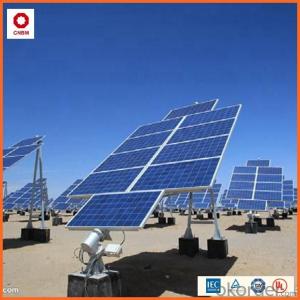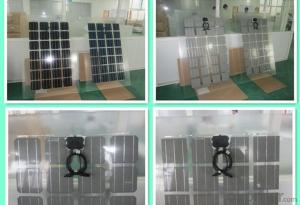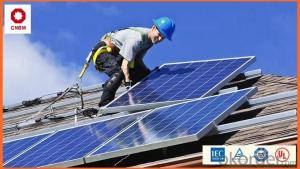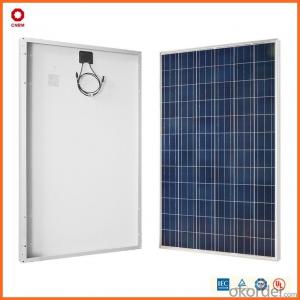70w Small Solar Panels in Stock China Manufacturer
- Loading Port:
- China main port
- Payment Terms:
- TT OR LC
- Min Order Qty:
- 1 watt
- Supply Capability:
- 10000000 watt/month
OKorder Service Pledge
OKorder Financial Service
You Might Also Like
Item specifice
Product Description:
Hot Sale !!! Quality and Safety of Small Poly Solar Panel 5w~150w
1. Rigorous quality control meets the highest international standards.
2. High-transmissivity low-iron tempered glass, strong aluminium frame.
3. Using UV-resistant silicon.
4. IS09001/14001/CE/TUV/UL
Warranties of Small Poly Solar Panel 35~85w
1. 10 years limited product warranty
2. 15 years at 90% of the minimal rated power output
3. 25 years at 80% of the minimal rated power output
Specification
Characteristics of Poly solar panels CNBM (245-320W) | |||||
Max Power Voltage Vmp(V) | 30.3 | 30.8 | 31.1 | 31.4 | 31.85 |
Max Power Current Imp(A) | 7.60 | 7.64 | 7.73 | 7.81 | 7.85 |
Open Circuit Voltage Voc(V) | 36.1 | 36.6 | 37 | 37.3 | 37.68 |
Short Circuit Current Isc(A) | 8.50 | 8.55 | 8.65 | 8.75 | 8.85 |
Max Power Pm(W) | 230W | 235W | 240W | 245W | 250W |
Temperature Coefficient of Cells Poly solar panels CNBM (245-320W) | |
NOCT | 45± 2 |
Temperature Coeffucients of Isc | 0.0492 |
Temperature Coeffucients of Voc | -0.3374 |
Temperature Coeffucients of Voc | -0.4677 |
Mechanical Data of Poly solar panels CNBM (245-320W) | |
Dimension | 1638 × 982 × 40 mm |
Weight | 19.5 kg |
No. of Cells and Connections | 60 (6 ×10) |
Tolerance | 0 ~ + 5 W |
Cell | Monocrystalline Cell 156 × 156 mm |
Packing | 624 Pcs/40ft(H) Container |
Limits of Poly solar panels CNBM (245-320W) | |
Operating Temperature | -40 to +85 |
Storage Temperature | -40 to +85 |
Max System Voltage | 1000VDC(IEC) / 600VDC(UL) |
Features of our products:
• High conversion efficiency mono/poly-crystalline amorphous silicon solar cells
• Modules incorporate high performance bypass diodes to minimize the power drop caused by shading
• High transmittance, low-iron tempered glass
• High performance EVA encapsulant to prevent destroying and water.
• AI frame: without screw, corner connection. 8 holes on the frame can be installed easily
• Good performance of preventing from atrocious weather such as wind and hails
• Certifications: CE IEC TUV VDE UL, Class I
• 10 years 90% power output warranty

Shipping of Small Poly Solar Panel 35~85w
By Sea | Delivery from Shanghai or Ningbo seaport |
By Air | Departure from Shanghai Pudong Airport |
By Express | Post by DHL, EMS, UPS, TNT. |
Features of our products:
• High conversion efficiency mono/poly-crystalline amorphous silicon solar cells
• Modules incorporate high performance bypass diodes to minimize the power drop caused by shading
• High transmittance, low-iron tempered glass
• High performance EVA encapsulant to prevent destroying and water.
• AI frame: without screw, corner connection. 8 holes on the frame can be installed easily
• Good performance of preventing from atrocious weather such as wind and hails
• Certifications: CE IEC TUV VDE UL, Class I
• 10 years 90% power output warranty
As a professional Solar Panel manufacturer and Supplier in China, we have our customers come around the whole world and our specialization has got a worldwide recognition. Meanwhile, with our superior quality, competitive price, prompt and excellent service, As main role in trade section of CNBM Group, CNBM International Corporation supplies products including Monocrystalline Solar Panel, Polycrystalline Solar Panel ( multicrystalline silicon Solar Panel) have received and enjoyed famous reputation in many countries and regions in the world.
- Q:How do solar energy systems handle power outages?
- Solar energy systems do not provide power during a power outage. However, systems that are connected to the grid can have battery storage or backup generators to provide electricity during such situations. Standalone solar systems with battery storage can also provide limited power during an outage, depending on the capacity of the batteries.
- Q:Can solar energy systems be used for powering data centers?
- Yes, solar energy systems can be used for powering data centers. Solar panels can be installed on the roofs or grounds of data centers to convert sunlight into electricity. This renewable energy source can help reduce reliance on traditional power grids and lower carbon emissions associated with data center operations. However, the suitability of solar power for data centers may depend on factors such as the available space, climate, and energy demands of the facility.
- Q:Can a solar energy system be installed in areas with frequent lightning strikes?
- Yes, a solar energy system can be installed in areas with frequent lightning strikes. However, it is important to take certain precautions to ensure the system's safety. Lightning can potentially damage solar panels, inverters, and other components of the system if proper protection measures are not in place. To mitigate the risk, several strategies can be implemented. Firstly, it is advisable to install a lightning protection system (LPS) that includes lightning rods, grounding systems, and surge protection devices. These systems are designed to redirect the lightning strike away from the solar panels and safely dissipate the electrical energy into the ground. Additionally, using high-quality surge protectors and lightning arrestors in the electrical and communication lines can help safeguard the system from power surges caused by lightning strikes. Moreover, selecting durable and robust solar panels and inverters that comply with industry standards for protection against lightning is crucial. Some manufacturers offer products specifically designed to withstand harsh weather conditions, including lightning strikes. Regular maintenance and inspections are also important to ensure the system remains safe and functional. This includes checking the integrity of the lightning protection system and inspecting the solar panels and other components for any signs of damage or wear. In summary, while it is possible to install a solar energy system in areas with frequent lightning strikes, proper precautions and protective measures must be taken to minimize the risk of damage. Working with experienced solar installers who are knowledgeable about lightning protection systems can help ensure the safe and efficient operation of the solar energy system even in high-risk areas.
- Q:What is the difference between a monofacial and bifacial solar panel?
- A monofacial solar panel has only one active side that absorbs sunlight, while a bifacial solar panel has two active sides, allowing it to capture sunlight from both the front and back. This enables bifacial panels to generate more electricity by utilizing reflected and diffused light, making them more efficient than monofacial panels.
- Q:What is the role of solar energy systems in promoting sustainability?
- Solar energy systems play a crucial role in promoting sustainability by harnessing the abundant and renewable energy from the sun. By generating electricity without relying on fossil fuels, solar power helps reduce greenhouse gas emissions and mitigate climate change. Additionally, solar energy systems contribute to energy independence, as they can be deployed on rooftops or in remote areas, reducing the need for long-distance transmission lines. Moreover, solar power has economic benefits, creating jobs and stimulating local economies. Overall, solar energy systems are a key component in transitioning to a more sustainable and clean energy future.
- Q:Can solar energy systems be used in areas with limited access to solar energy training programs?
- Yes, solar energy systems can be used in areas with limited access to solar energy training programs. While training programs can be beneficial in helping individuals understand how to design, install, and maintain solar energy systems, there are various resources available that can still enable people to harness solar energy even without formal training. Online resources, books, and manuals can provide valuable information on solar energy systems, and local experts or organizations can offer guidance and support. Additionally, some solar energy companies may offer on-the-job training or apprenticeship programs to help individuals acquire the necessary skills. Ultimately, with determination and resourcefulness, individuals in areas with limited access to training programs can still utilize solar energy systems effectively.
- Q:Solar PV systems
- Article 1 in order to regulate the construction of distributed photovoltaic power generation project management, promote distributed photovoltaic applications, according to the "People's Republic of China renewable energy law", "People's Republic of China, People's Republic of China" power law "administrative licensing law", and the "State Council on a number of opinions" to promote the healthy development of the PV industry, these measures are formulated.
- Q:How do solar energy systems impact noise pollution?
- Solar energy systems have a minimal impact on noise pollution as they operate silently, without any moving parts or combustion. This makes them an ideal source of renewable energy, ensuring a quieter and more peaceful environment.
- Q:Can solar energy systems be used for powering disaster relief efforts?
- Yes, solar energy systems can be used for powering disaster relief efforts. Solar power provides a reliable and sustainable source of energy, especially in areas where the conventional power grid may be disrupted or unavailable due to a disaster. Solar energy systems can be quickly deployed and can provide electricity to power medical facilities, communication systems, lighting, and other essential equipment during relief operations. They are also cost-effective in the long run and reduce dependency on fossil fuels, making solar energy an ideal solution for disaster-affected areas.
- Q:How do solar energy systems impact waste reduction?
- Solar energy systems have a significant impact on waste reduction by reducing the reliance on fossil fuels, which in turn decreases the production of harmful pollutants and greenhouse gas emissions. Additionally, solar panels have a long lifespan and require minimal maintenance, leading to reduced waste generation compared to traditional energy sources.
1. Manufacturer Overview |
|
|---|---|
| Location | |
| Year Established | |
| Annual Output Value | |
| Main Markets | |
| Company Certifications | |
2. Manufacturer Certificates |
|
|---|---|
| a) Certification Name | |
| Range | |
| Reference | |
| Validity Period | |
3. Manufacturer Capability |
|
|---|---|
| a)Trade Capacity | |
| Nearest Port | |
| Export Percentage | |
| No.of Employees in Trade Department | |
| Language Spoken: | |
| b)Factory Information | |
| Factory Size: | |
| No. of Production Lines | |
| Contract Manufacturing | |
| Product Price Range | |
Send your message to us
70w Small Solar Panels in Stock China Manufacturer
- Loading Port:
- China main port
- Payment Terms:
- TT OR LC
- Min Order Qty:
- 1 watt
- Supply Capability:
- 10000000 watt/month
OKorder Service Pledge
OKorder Financial Service
Similar products
New products
Hot products
Hot Searches
Related keywords
































